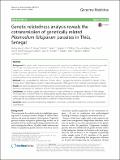Genetic relatedness analysis reveals the cotransmission of genetically related Plasmodium falciparum parasites in Thiès, Senegal

View/
Author
Griggs, Allison D.
Schaffner, Stephen F.
Ndiaye, Daouda
Deme, Awa B.
MacInnis, Bronwyn
Volkman, Sarah K.
Neafsey, Daniel E.
Note: Order does not necessarily reflect citation order of authors.
Published Version
https://doi.org/10.1186/s13073-017-0398-0Metadata
Show full item recordCitation
Wong, W., A. D. Griggs, R. F. Daniels, S. F. Schaffner, D. Ndiaye, A. K. Bei, A. B. Deme, et al. 2017. “Genetic relatedness analysis reveals the cotransmission of genetically related Plasmodium falciparum parasites in Thiès, Senegal.” Genome Medicine 9 (1): 5. doi:10.1186/s13073-017-0398-0. http://dx.doi.org/10.1186/s13073-017-0398-0.Abstract
Background: As public health interventions drive parasite populations to elimination, genetic epidemiology models that incorporate population genomics can be powerful tools for evaluating the effectiveness of continued intervention. However, current genetic epidemiology models may not accurately simulate the population genetic profile of parasite populations, particularly with regard to polygenomic (multi-strain) infections. Current epidemiology models simulate polygenomic infections via superinfection (multiple mosquito bites), despite growing evidence that cotransmission (a single mosquito bite) may contribute to polygenomic infections. Methods: Here, we quantified the relatedness of strains within 31 polygenomic infections collected from patients in Thiès, Senegal using a hidden Markov model to measure the proportion of the genome that is inferred to be identical by descent. Results: We found that polygenomic infections can be composed of highly related parasites and that superinfection models drastically underestimate the relatedness of strains within polygenomic infections. Conclusions: Our findings suggest that cotransmission is a major contributor to polygenomic infections in Thiès, Senegal. The incorporation of cotransmission into existing genetic epidemiology models may enhance our ability to characterize and predict changes in population structure associated with reduced transmission intensities and the emergence of important phenotypes like drug resistance that threaten to undermine malaria elimination activities. Electronic supplementary material The online version of this article (doi:10.1186/s13073-017-0398-0) contains supplementary material, which is available to authorized users.Other Sources
http://www.ncbi.nlm.nih.gov/pmc/articles/PMC5260019/pdf/Terms of Use
This article is made available under the terms and conditions applicable to Other Posted Material, as set forth at http://nrs.harvard.edu/urn-3:HUL.InstRepos:dash.current.terms-of-use#LAACitable link to this page
http://nrs.harvard.edu/urn-3:HUL.InstRepos:30371156
Collections
- FAS Scholarly Articles [18292]
- SPH Scholarly Articles [6362]
Contact administrator regarding this item (to report mistakes or request changes)


